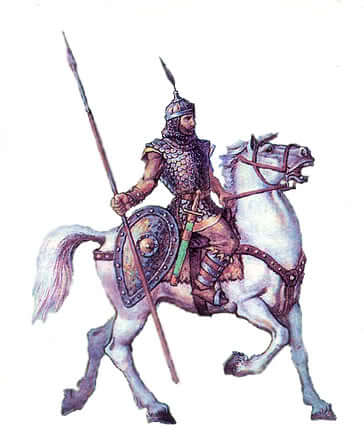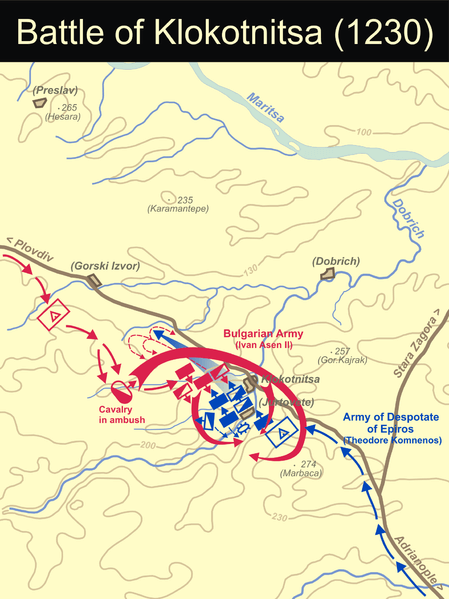Battle of Klokotnitsa – Bulgarians vs Greeks
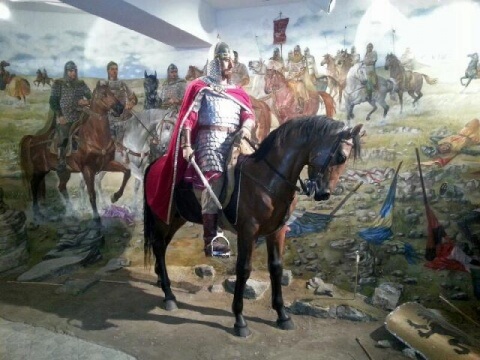 |
| Tsar Kaloyan of Bulgaria In 1205 Tsar Kaloyan defeated the Latins at Serres and captured Philippopolis (Plovdiv), overrunning much of the territory of the Latin Empire in Thrace and Macedonia. The fall of Constantinople in 1204 to the Fourth Crusade saw endless battles over territory in the Balkans. |
Despotate of Epirus
The Despotate or Principality of Epirus was one of the Byzantine Greek successor states of the Byzantine Empire that emerged in the aftermath of the Fourth Crusade in 1204. It claimed to be the legitimate successor of the Byzantine Empire, along with the Empire of Nicaea, and the Empire of Trebizond. Conquered by the Serbian Kingdom in 1337, it was restored in 1356 and existed until the Ottoman conquest in 1479.
The Epirote state was founded in 1205 by Michael Komnenos Doukas, a cousin of the Byzantine Emperors Isaac II Angelos and Alexios III Angelos.
The Battle of Klokotnitsa occurred on 9 March 1230 near the village of Klokotnitsa in Haskovo Province, Bulgaria.
As a result, the Second Bulgarian Empire emerged once again as the most powerful state in Eastern Europe and the power of the Despotate of Epirus faded. The battle is often considered by historians to be the luckiest and most fruitful in Bulgarian military history.
Origins of the Conflict
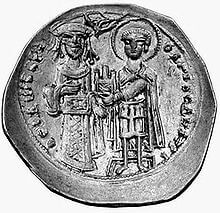 |
| Theodore Komnenos Doukas |
Theodore Komnenos Doukas was ruler of Epirus from 1215 to 1230 and of Thessalonica from 1224 to 1230.
Initially in the service of the Nicaean Emperor Theodore I Laskaris, Theodore joined his half-brother Michael I in Epirus in c. 1210. When Michael was murdered in 1215, Theodore took his place and embarked on a policy of aggressive expansion after allying himself with Serbia and the Albanian clans.
Taking advantage of the temporary weakness of Bulgaria and the Kingdom of Thessalonica, Theodore seized most of Macedonia (with Ohrid) and Thessaly in c. 1216. In 1217, when the new Latin Emperor of Constantinople Peter II of Courtenay attempted to cross through Epirus to reach his lands, Theodore defeated and captured him. In 1220 he tookBeroia, and in 1221 Serres and Drama, tightening the noose around Thessalonica.
Around 1221–1222 the Bulgarian Emperor Ivan Asen II made an alliance with Theodore Komnenos Doukas of Epirus. Secured by the treaty, Theodore managed to conquer Thessalonica from the Latin Empire, as well as Bulgarian lands in Macedonia including Ohrid.
Theodore’s forces advanced through the Aegean coast of Thrace and in 1225 seized Adrianople and the surrounding portions of Thrace from the Nicaeans. Elated by his success, Theodore arranged for hiscoronation as Byzantine Emperor in 1225 or 1227 by the autocephalous archbishop of Ohrid, Demetrios Chomatianos.
After the death of the Latin Emperor Robert of Courtenay in 1228, Bulgaria’s Ivan Asen II was considered the most probable choice for regent of Baldwin II.
Theodore was worried by the alliance of Ivan Asen II of Bulgaria with the Latin Empire of Constantinople. Theodore thought that Bulgaria was the only obstacle left on his way to making him Emperor at Constantinople and restoring the Roman Empire. In the beginning of March 1230 he invaded the country, breaking the peace treaty and without a declaration of war.
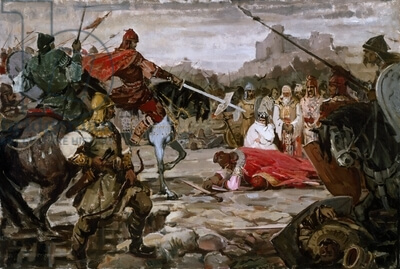 |
| Battle of Klokotnitsa March 9, 1230 which saw Tsar Ivan Asen II defeat Theodore of Epirus, Bulgaria, 13th century / De Agostini Picture Library / A. de Gregorio / The Bridgeman Art Library |
The Battle
Theodore Komnenos summoned an enormous army including western mercenaries. He was so confident for his victory that he took the whole royal court with himself including his wife and children.
His army moved slowly and plundered the villages on its way. When the Bulgarian tsar learned that the state was invaded, he gathered a small army of a few thousand men and quickly marched southwards. For four days the Bulgarians covered a distance three times longer than Theodore’s army for a week.
On 9 March, the two armies met near the village of Klokotnitsa. It is believed that Ivan Asen II ordered the broken mutual protection treaty to be stuck on his spear and used as a flag. He was a good tactician and managed to surround the enemy who was surprised to meet the Bulgarians so soon. The battle continued until sunset.
The Epirotians were completely defeated, only a small force under the despot’s brother Manuel managed to escape the battlefield. The rest were killed in the battle or captured, including the royal court of Epirus and Theodore himself.
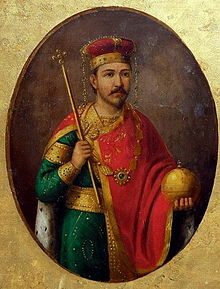 |
| Tsar Ivan Asen II of Bulgaria |
Ivan Asen II’s Tarnovo Inscription
In order to commemorate the battle, the Bulgarian emperor had an inscription carved in one of the marble columns of the church “Holy Forty Martyrs” in the capital of the Bulgarian empire Great Tarnovo. Among all existing documents the text of this inscription is the most accurate evidence of the outcome and the aftermath of the battle:
“In the year 6738 (1230), third indiction. John Asen in God Christ true Tsar and sovereign of the Bulgarians, son of the old Tsar Asen, raised from the foundations and decorated with art this holy church in the name of the Holy 40 Martyrs, with the help of whom in the twelfth year of my reign when this temple was being decorated. I made war in Byzantium and defeated the Greek army and captured their Tsar, Kyr Teodore Komnenos, together with all his bolyars. And I occupied all of his land from Odrin (Adrianople) to Drach (Dyrrhachium), Greek and also Albanian and Serbian; and the towns around Constantinople and this very town were ruled by the Frizes (Latins), but they also subjugated to my empire; because they had no other Tsar but me and thanks to me they spent their days, because God ordered this, because without Him neither a deed, nor a word is done. Glory to Him forever, amen.”
Aftermath
Ivan Asen II immediately released the captured soldiers without any conditions and the nobles were taken toTarnovo. At some point during his captivity he became involved in a conspiracy and was blinded.
Theodore’s lands were divided between Ivan Asen II (who took over Thrace, Macedonia, and Albania), Theodore’s brothers Manuel (who took Thessalonica) and Constantine (who took Acarnania), and Theodore’s nephew Michael II (who took Epirus).
Battle of Klokotnitsa
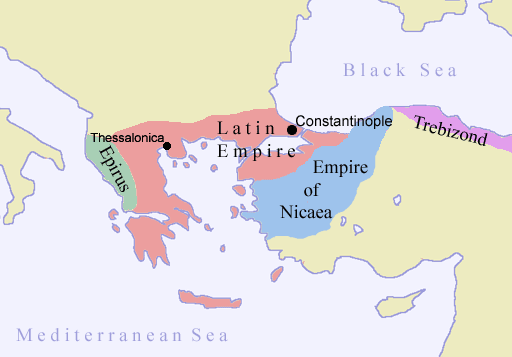 |
| The Latin Empire, Empire of Nicaea, Empire of Trebizond and the Despotate of Epirus about 1204. |
 |
| The growth of the Despotate of Epirus. |
